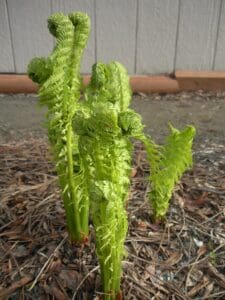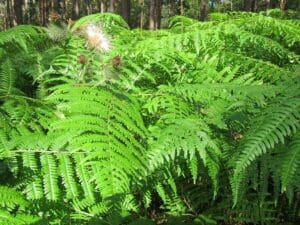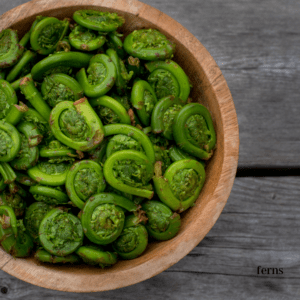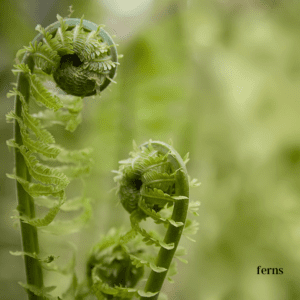Over the past couple of years I’ve heard, on and off, different tales about fern edibility. Some saying they’re all highly carcinogenic and others saying they’re delightful and highly sought after species for restaurants. I wanted to spend a little time researching this and thought I’d write my findings up here.
I’m thrilled to guide you through the enchanting world of edible ferns, a realm where spring & early summer brings the delicate unfurling of fiddlehead ferns, promising culinary delights that captivate foragers and foodies alike.
As we explore the lush landscapes and the hidden nooks of British woodlands, we’ll uncover the secrets of foraging fiddleheads, ensuring every foray into the wild turns into a safe and savoury expedition.
Embarking on this journey, we’ll dive into the diversity of edible ferns, from the heralded fiddlehead to the lesser-known but equally intriguing varieties that grace our countryside. The quest for these wild greens isn’t just a foraging fiddlehead adventure; it’s a pathway to understanding the delicate balance of edibility and toxicity that nature intertwines.
Alongside demystifying the myths surrounding ferns, this guide aims to be your compass in identifying & harvesting.
Understanding Fern Edibility and Toxicity
Identifying Edible Ferns in the UK
- Athyrium filix-femina (Lady Fern) – Some sources mention that young shoots can be eaten after proper preparation, but this is not commonly practiced in the UK.
- Matteuccia struthiopteris (Ostrich Fern) – While not native to the UK, it is sometimes cultivated. The fiddleheads (young shoots) are considered edible when cooked properly.
Non-Edible or Toxic Ferns in the UK
- Pteridium aquilinum (Bracken) – Contains ptaquiloside, toxic and potentially carcinogenic.
- Dryopteris filix-mas (Male Fern) – Considered toxic.
- Asplenium scolopendrium (Hart’s-tongue Fern) – Not typically consumed, may contain toxins.
- Asplenium trichomanes (Maidenhair Spleenwort) – Not typically consumed.
- Polystichum setiferum (Soft Shield-fern) – Not typically consumed.
- Polystichum aculeatum (Hard Shield-fern) – Not typically consumed.
- Adiantum capillus-veneris (Maidenhair Fern) – Not typically consumed.
- Blechnum spicant (Hard Fern) – Not typically consumed.
- Cystopteris fragilis (Brittle Bladder-fern) – Not typically consumed.
- Osmunda regalis (Royal Fern) – Fiddleheads have been eaten in some cultures, but caution is advised.
- Phegopteris connectilis (Beech Fern) – Not typically consumed.
- Thelypteris palustris (Marsh Fern) – Not typically consumed.
- Woodwardia radicans (European Chain Fern) – Not typically consumed.
- Polypodium vulgare (Common Polypody) – Rhizomes have been used as a flavoring and sweetener, but not commonly eaten.
- Athyrium distentifolium (Alpine Lady-fern) – Not typically consumed.
- Dryopteris affinis (Golden-scaled Male Fern) – Not typically consumed.
Toxic Compounds in Ferns and Their Effects
- Bracken Ferns: These ferns contain ptaquiloside, a known carcinogen, which can be harmful if consumed in large quantities. However, the carcinogenic effects can be mitigated by proper cooking methods such as boiling and sautéeing. It’s important to consume these ferns in moderation and not on a daily basis to avoid potential health risks.
- Fiddleheads: It’s essential to never consume fiddleheads raw as they can be toxic and potentially cause food poisoning. Proper preparation involves boiling them for at least 10 to 15 minutes before sautéeing or using them in recipes.
- General Safety Tips When Eating Ferns: Always ensure ferns are thoroughly cooked to reduce toxicity. Avoid consuming any ferns that you cannot positively identify as safe, and consider the local environmental conditions, as some ferns accumulate toxins differently based on soil and water conditions.
Popular Edible Ferns in the UK
Ostrich Fern (Matteuccia struthiopteris)
The Ostrich Fern, scientifically known as Matteuccia struthiopteris, is celebrated for its large, pale green, lacy fronds which make it not only a visual delight but also a popular choice for edible fern enthusiasts in the UK. This fern thrives in moist, dappled shade and is ideally suited for planting in groups near ponds, in woodland settings, or in large containers on shady patios. Its ability to spread slowly through underground rhizomes allows it to form natural colonies, which are both aesthetically pleasing and functional. The Royal Horticultural Society has recognized its ornamental value with an Award of Garden Merit (AGM).

Ostrich ferns are also known for their edibility, particularly the young fronds, or fiddleheads, which emerge in the spring. These are harvested for their unique flavor and are a delightful addition to various dishes. It’s important to note that while Matteuccia struthiopteris has no reported toxic effects, it should be cooked properly to enhance its taste and digestibility.
Bracken Fern (Pteridium aquilinum) – Caution Advised
On the other hand, Bracken Fern, or Pteridium aquilinum, presents a different scenario. This fern is known for its widespread presence and ability to dominate landscapes. It grows vigorously and is often the predominant species in the areas it inhabits. Bracken is not only a robust grower but also a producer of significant amounts of toxic compounds, which can have allelopathic effects on surrounding plant species.

The International Agency for Research on Cancer (IARC) has classified Bracken Fern as possibly carcinogenic to humans, highlighting the need for caution in its consumption. The primary carcinogen identified in Bracken is ptaquiloside (PTA), which can also degrade into less harmful compounds depending on environmental conditions such as soil pH and microbial activity. Despite its historical use in cuisines, particularly in Asia where it is cooked and consumed in dishes like soups, it is crucial to handle Bracken with care and to limit its intake due to its potential health risks.
When foraging or cultivating these ferns, it’s essential to distinguish between them clearly and to process them appropriately to ensure they are safe for consumption. This includes adhering to specific preparation methods that mitigate potential toxicity, thereby making these ferns a safe and enjoyable part of your diet.
Health Benefits and Nutritional Value of Edible Ferns
Vitamin Content
Fiddlehead ferns are a powerhouse of essential vitamins. They provide a significant amount of Vitamin A, with 100 grams offering 3617 IU, which is about 120% of the daily recommended intake. This vitamin is crucial for maintaining the integrity of skin and mucosa, and it plays a vital role in vision. Studies suggest that diets rich in Vitamin A can help protect against lung and oral cavity cancers. Additionally, fiddleheads are an excellent source of Vitamin C, providing 44% of the daily requirement per 100 grams. This vitamin is not only a potent antioxidant but also essential for strengthening the immune system and combating inflammation and viral infections.
Antioxidant Properties
Fiddlehead ferns excel in their antioxidant capacity, often surpassing common vegetables like spinach and rocket. The total phenol content in fiddleheads reaches up to 220 mg·g−1 of extract dry weight, showcasing their ability to combat oxidative stress. The Oxygen Radical Absorbance Capacity (ORAC) assay reveals that many fern species have over 1 g Trolox equivalent per gram of extract dry weight, highlighting their superior antioxidant properties. These antioxidants, including carotenes and flavonoids, help neutralize harmful free radicals, thereby offering protection from various chronic diseases, including cancers.
Fiddleheads also contain a beneficial mix of omega-3 and omega-6 fatty acids, with a healthy n6/n3 ratio that is particularly advantageous for individuals who do not consume fish. This balance of fatty acids contributes to heart health and may reduce the risk of chronic diseases such as heart disease and stroke.
Harvesting and Preparation Tips
Best Time to Harvest
- Timing is Crucial: For the best quality and flavour, fiddlehead ferns should be harvested when they’re about one to four inches in height and still tightly coiled. This typically occurs from late April through late June, depending on your climate, but the window can be as short as two weeks.
- Identifying the Right Stage: Look for ferns that are tightly furled; avoid any that have begun to unfurl as they can become woody and unpalatable. The ideal time is when they just start to emerge, showing an inch or two above the ground.
 How to Properly Clean and Cook Ferns
How to Properly Clean and Cook Ferns
Cleaning Process
- Initial Cleaning: Begin by removing the brown papery covering, which is often present on the fiddleheads. This can be done by gently rubbing them while they are dry or during the washing process.
- Washing: Place the fiddleheads in a colander and rinse thoroughly under cold water. Follow by submerging them in a bowl of clean, cool water, agitating slightly to dislodge any residual dirt or debris. Repeat this process several times until the water runs clear and the fiddleheads appear clean.
Cooking Techniques
- Boiling: To ensure safety and remove any bitterness, boiling fiddleheads is recommended. Bring a pot of lightly salted water to a rolling boil, add the cleaned fiddleheads ensuring they are fully submerged, and boil for 15 minutes. This method is crucial as undercooked fiddleheads can cause foodborne illnesses.
- Steaming: Alternatively, steaming is an effective cooking method. Place the fiddleheads in a steamer over boiling water, cover, and steam for 10-12 minutes. This method helps retain their vibrant colour and texture.
- Post-Cooking Handling: After boiling or steaming, fiddleheads can be lightly sautéed in butter or olive oil to enhance their flavour. Season with salt and pepper to taste. Ensure not to overcook during this final stage to maintain a slight crispness.
By following these guidelines, you can enjoy the unique flavour and nutritional benefits of fiddleheads safely and sustainably.
Remember, proper identification and preparation are key to a delightful culinary experience with these seasonal delicacies.
Common Mistakes to Avoid
Misidentification Risks
- Thiaminase Presence in Ferns: A critical error often made is the consumption of ferns containing thiaminase without adequate preparation. This enzyme, found in many fern species, breaks down thiamine (vitamin B1) and can lead to beri-beri illness when ferns are consumed raw or undercooked frequently. It’s crucial to cook these ferns thoroughly and discard the cooking water as per traditional recipes to significantly reduce thiaminase levels. However, occasional consumption is generally safe.
- Carcinogenic Compounds in Bracken: Another frequent mistake involves underestimating the presence of carcinogenic agents in some ferns, notably bracken (Pteridium), which contains ptaquilioside, a potent carcinogen. While not all fern species carry this risk, it’s vital to be aware of which ones do. Proper boiling and discarding the water can reduce, but not eliminate, these toxins. Therefore, understanding which ferns pose these risks and how to process them is essential for safe consumption.
Overconsumption Effects
- Health Risks from Fiddleheads: Despite their nutritional benefits, fiddlehead ferns can be toxic if not handled correctly. There have been several instances of foodborne illness linked to the consumption of raw or undercooked fiddleheads. Symptoms such as diarrhea, nausea, vomiting, stomach cramps, and headaches can appear within hours and last up to three days. Always ensure fiddleheads are properly cleaned and cooked to prevent these issues. This includes boiling them for at least 15 minutes before any further preparation like sautéing or incorporating into dishes.
Incorporating Ferns into Your Diet
Simple Recipes and Serving Suggestions

- Sautéed Fiddleheads: Start by cleaning your fiddleheads thoroughly, removing any brown papery skin and trimming the ends. Boil them for 10-15 minutes to remove any bitterness and potential toxins. For a simple yet delicious dish, sauté the boiled fiddleheads in butter with minced garlic and a squeeze of lemon juice. This method enhances their natural flavour, which is often described as a cross between asparagus, broccoli, and mushrooms.
- Roasted Fiddlehead Ferns: If you’re lucky enough to find fiddleheads during their brief season from late April to early June, try roasting them. After cleaning and boiling, toss them with olive oil, salt, and pepper, and roast in a preheated oven at 400°F for about 10-15 minutes. This brings out a crisp texture and earthy flavour, reminiscent of asparagus.
- Fiddlehead Fern Salad: For a refreshing spring salad, blanch your fiddleheads and then cool them. Mix with fresh garden vegetables and a vinaigrette of your choice. Add herbs like mint or dill to enhance the greens’ natural flavours.
- Crunchy Pickled Fiddleheads: Pickling is a great way to preserve the unique flavour of fiddleheads beyond their season. Blanch and cool the fiddleheads, then pickle them with vinegar, water, sugar, and spices. They make a crunchy, tangy addition to salads or as a standalone snack.
- Fiddlehead Soup: Combine par-cooked fiddleheads with vegetable broth, a mix of spring vegetables, and herbs. This soup is light yet nourishing and highlights the subtle flavors of fiddleheads complemented by the freshness of seasonal produce.
- Integrating into International Dishes: Fiddleheads can be a unique addition to global dishes. Try incorporating them into a Korean Gosari namul or a Japanese-style Gomae. These dishes allow the fiddleheads to shine while introducing them in a new and exciting context.
Remember, while fiddleheads are a delightful spring treat, they must be cooked properly to avoid any potential health risks. Always boil them before incorporating into any dish to ensure they are safe to eat.
Throughout this guide, we’ve journeyed through the verdant underbrush of the UK’s forests and fields, unraveling the mysteries of edible ferns – from their early spring emergence as fiddleheads to their potential as nutritious and flavorful additions to our diets. We corrected myths about their edibility and toxicity, providing a thorough understanding of how to safely identify, harvest, and prepare these natural delights. The importance of discerning between edible and potentially toxic varieties cannot be overstated, as we’ve explored the culinary potential of ferns like the ostrich and the caution-required bracken, alongside the health benefits they offer when properly processed.
Embracing the wild bounty of ferns enriches our connection to nature and the seasonal rhythms that dictate their availability. It’s crucial that enthusiasts and foragers alike proceed with knowledge and respect for these plants, armed with the insights on safety and preparation shared here. As we conclude this guide, let the lure of discovering and incorporating ferns into your cuisine inspire further exploration and experimentation within the bountiful forests of the UK. May your foraging endeavors be safe, sustainable, and ultimately, satisfying to both palette and spirit, as you delve into the green world of ferns with the wisdom and curiosity of a true nature aficionado.
FAQs
1. How can one identify edible ferns in the wild?
To identify edible ferns, particularly the ostrich fern, look for fronds that are uncoiling and shedding a brown papery husk. A key characteristic of the ostrich fern is a distinctive groove along the stem that resembles a celery stalk. Ensure the fern does not have the brown papery covering; if it does, it may be too mature to consume safely.
2. Can ferns be safely eaten in the UK?
While ferns contain thiaminase, an enzyme that can lead to Vitamin B1 deficiency, cooking them thoroughly neutralizes this enzyme, making them safe to eat. Ferns can be enjoyed as a seasonal delicacy in small amounts or as a survival food under more extreme conditions.
3. Which fern species is best for harvesting edible fiddleheads?
The best fern for edible fiddleheads is typically the ostrich fern. However, on the West Coast, the lady fern (Athyrium filix-femina) is also harvested for its fiddleheads. While slightly different in taste compared to the ostrich fern, lady ferns are still a good edible option.
4. What are the guidelines for cooking fiddleheads to ensure they are safe to eat?
To safely prepare fiddleheads, they should be cleaned thoroughly and cooked by boiling or steaming for several minutes. This process helps eliminate any harmful bacteria and breaks down enzymes that can interfere with nutrient absorption.
References
[1] – https://outdooradventuresampler.com/ultimate-guide-to-wild-edibles-fiddleheads/
[2] – https://foragerchef.com/how-to-identify-and-cook-fiddlehead-ferns/
[3] – https://fearlesseating.net/fiddleheads/
[4] – https://www.firstchoiceproduce.com/blog/our-guide-to-fiddleheads-what-are-fiddlehead-ferns/
[5] – https://www.daringgourmet.com/wild-foraging-how-to-identify-harvest-and-prepare-bracken-fern-fiddleheads/
[6] – https://foragerchef.com/how-to-identify-and-cook-fiddlehead-ferns/



 How to Properly Clean and Cook Ferns
How to Properly Clean and Cook Ferns

